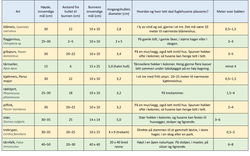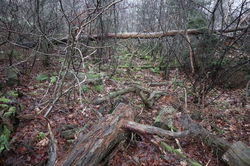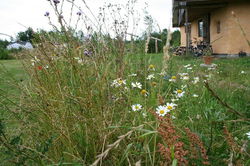WINGS Bird box - entrance
By Katrine Turner.
Where would starlings build their nests if we didn't put up nesting boxes for them? Before humans came along and took control of the landscape, birds built their nests in old trees, in places hidden by tall grass, in bushes or on rocks, but many of these options have gradually disappeared as we have expanded, and birds often lack opportunities to breed. Most urban spaces would benefit greatly from putting up nest boxes for birds as a replacement for their lack of natural nesting places.
Different bird species have different preferences as regards where, when and how they want to build their nests. Swallows and swifts build under canopies, eaves and in old barns, where they are a pleasure to watch as they elegantly dash in and out—a sure sign that summer is on its way. Swallows mix mud with their saliva, and they are good at repairing old nests to keep using them. Blackbirds weave their nests out of twigs and moss and hide them in bushes, hedges or treetops. However, many of the birds we see in urban areas prefer to use spaces they could previously find in old trees. These birds would be happy to use nesting boxes. The size of both the nesting box and the entrance hole can be adapted to attract specific bird species. And maybe you didn’t know that it’s not only the classic garden bird species that benefit from man-made houses?
It's important to think about the size of the entrance hole and location when setting up bird boxes, as some species can be quite picky. Thought it’s always better to have a random or incorrect hole size than not put up a bird box at all. It’s a good idea to adapt the configuration to the species of bird you want to inhabit the box. Some species such as sparrows or starlings like to live close together in colonies, while others such as great tits and blue tits are territorial, so the boxes must be put up at a good distance from each other, or neighbourly disputes will occur. Similarly, some birds want to breed in the shelter of bushes, while others would prefer to be up high and have a good view, e.g. kestrels. We have gathered this information together in the table below.
You won’t necessarily have birds moving in right away, but they will eventually. It may be a good idea to put up the boxes in the autumn or winter, so that the birds can get used to them and the human smell can wear off. When the nest boxes are set up and birds have moved in, they should not be disturbed. Although the adult birds might not be home, they will probably be nearby and watching as you look for the small chirping chicks. This makes the birds stressed and in the worst-case scenario might even force them to find a new place to breed and leave the chicks in the box. You don’t need to clean bird boxes, the birds can do this for themselves, and if you don’t clean them, you might get lucky and have a colony of bumblebees move into the box the next year. This won't happen if you clean the box because they reuse the birds’ nesting material. As well as the nesting boxes themselves, it’s always a good idea to have a lot of scrub and brushwood and preferably native flowers nearby, where the birds can find shelter and peace, and insects they can eat, as not all species of birds eat seeds.


